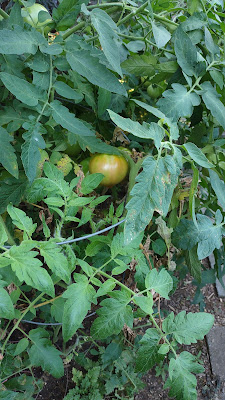The tomatoes are coming in!
It's my husband's favorite time of the summer. He eats corn on the cob and fresh tomatoes as much as he can. Last weekend, we noticed that we had a good half dozen tomatoes that would soon be a bright red. "They'll be all ready when we get back," my husband said. We rejoiced that our garden has been squirrel and chipmunk free for the past few months.
Unfortunately the critters heard us.
They got all the tomatoes except for one. Sometimes they don't even pick them off the vine. Just take one lousy bite and then move on to the next one. My neighbor said they want the red ones because they need fluids and the juice helps the animal. Yes we haven't had much rain and the temperatures are oppressive.
"Leave a bowl of water out for them," my neighbor advised. Oh yeh, we did that...and our outdoor camera recorded a menagerie of wildlife coming to the garden for a drink: rabbits, feral cats, foxes and skunks. And guess what? The freaking squirrels still ate the tomatoes. We took the bowl away.
So we are back to harvesting tomatoes as soon as they show color. Actually, for those of you who face similar challenges, this article here may be of some interest. It's actually best to pick tomatoes once they begin to show color and it explains the science and how to ripen tomatoes indoors. It's very interesting.
But let's talk about tomato quilts. Actually any of us that have viewed 19th century quilts--particularly the red and green applique kind--have likely seen a tomato quilt. That is because another phrase for tomatoes is Love Apple.
Brackman has 4 versions of this pattern in her Encylcopedia of Applique. Here's a couple versions I found on the internet:
1932, Detroit Free Press
Apparently the French thought that tomatoes had aphrodisiac properties and so it was referred to as pomme d'amour (or love apple). Tomatoes were native to South America and it was only when that continent was being explored that the fruit was brought to the Old World (Europe); still it took a few centuries before Europeans completely embraced the fruit.
Prior to the pandemic, when I was still traveling and giving programs, I often visited the Love Apple Quilt Guild in New Jersey. The name of the guild made perfect sense to me. New Jersey is the 8th highest producer of tomatoes--which is saying a lot since it is also the 4th smallest state. There is something about driving past the tomato fields in that state that is really charming. All those pops of red in a green field really takes one's breath away. By the way, the tomato is the official vegetable of New Jersey (despite it being a fruit--the blueberry is the official fruit of the state).
Maybe you are similar to me and always wondered what that striped aspect of the fruit on the quilt pattern meant? I mean is it just a shading technique?
Maybe our foremothers were telling us to pick the tomato before it completely ripens and the squirrels or the chipmunks get it. 😂
Have a safe and happy day!







No comments:
Post a Comment